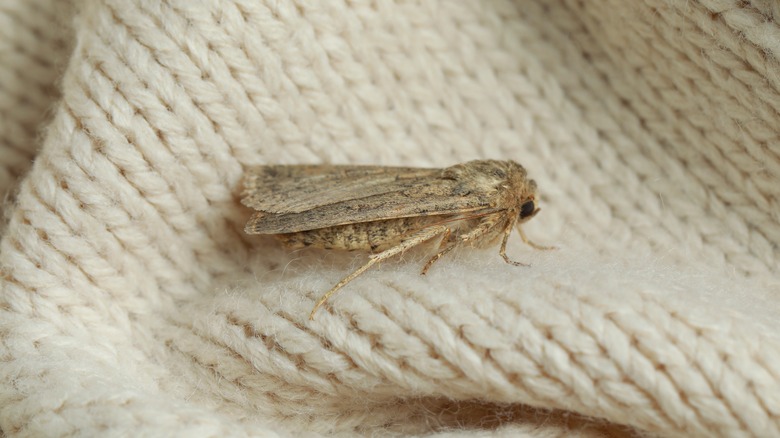The Unexpected Freezer Trick That Will Save Your Sweaters From Moths
Moths can be frustrating to deal with, especially when they find their way to your nice sweaters. Discovering moths have gotten to your belongings and made holes in your clothes may lead you to question how the flying insects can do so much damage. Adult moths are actually not responsible for gnawing holes in sweaters — their larvae are the culprit. When adult moths lay eggs on your clothes, their larvae then consume the natural fibers that sweaters and other clothing items are often made of, along with the bodily fluids left on the synthetic fibers. If the idea of moth larvae feeding on your sweaters makes your skin crawl, fear not because there is a rather simple solution.
Placing your at-risk items in the freezer can keep these critters from destroying your wardrobe. There are quite a few ways to keep moths out of your closet, but you may find this to be one of the easiest and most practical methods. While this freezer trick is simple compared to other moth-damage prevention tips, there are a few things to keep in mind to ensure you freeze your items properly so that your sweaters are actually protected.
The freezer trick explained
So, how exactly does freezing sweaters protect them from moth damage? According to Cornell University's Insect Diagnostic Laboratory, the moth larvae that destroy clothes become inactive below 40 degrees Fahrenheit. The U.S. Department of Agriculture recommends freezers be set at 0 degrees Fahrenheit, so freezers that meet this recommendation should do the trick.
It is important to note that although larvae are not active when kept at temperatures below 40 degrees, this alone does not kill them. To effectively freeze your sweaters to kill any moth larvae and prevent them from feeding and making holes, they must be heated to at least 70 degrees. They should then be quickly placed in a freezer at 0 degrees for at least 72 hours. This rapid temperature drop is what actually kills the moth larvae rather than just making them inactive.
To protect your sweaters from moths using the freezer trick, first heat your items to at least 70 degrees. If you cannot be sure that they are already being stored at or above 70 degrees, you can heat them outside on a warm day to get them to the necessary temperature. You may also wash them in hot water and dry on high heat. After your items are appropriately heated, seal them in storage bags and place them in the freezer for at least 72 hours. After removing your clothes from the freezer, ensure they are kept away from any other items or areas that may contain moths or moth larvae.
Keep moths away from your sweaters for good
If you are dealing with an ongoing moth infestation, you may need to contact a professional pest control service to ensure these insects do not continue to latch onto your clothes. Beyond that, you may want to take steps to ensure that your home is not a place moths want to enter. According to the University of California Agriculture and Natural Resources, it may help to minimize humidity in your home. Dehumidifiers and the appropriate use of exhaust fans are a good way to do this.
It is also beneficial to clean areas of your home that may not get enough attention during periodic cleanings, such as in and around heaters and vents, underneath furniture, and those hard-to-reach spaces in storage and clothing closets. Another key component to keeping moths away is early detection. The earlier you identify the problem, the faster you can take the steps needed to get them away from your clothes and out of your home.
Inspect clothing items to determine whether moth larvae have attached to them. They will look like silken tubes and are typically located in the crevices of clothes — think collars, cuffs, or pockets. Incorporate these prevention and detection methods after freezing potentially infested items to increase effectiveness.


